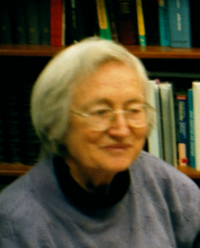Frances Bennion Archive: Difference between revisions
No edit summary |
No edit summary |
||
| (4 intermediate revisions by the same user not shown) | |||
| Line 1: | Line 1: | ||
[[ | [[File:Fran2001.PNG|200px|thumb|left|<small>Fran Bennion (2001)</small>.]] Frances Lusk Bennion worked as a musical data specialist at CCARH (the Center for Computer Assisted Research in the Humanities) from 1985 until her retirement at the end of 2010. She was especially conversant with string and orchestral music. She played cello and piano, but the larger part of her musical background may have consisted of many years of accompanying her four gifted children to music lessons up and down the San Francisco peninsula. | ||
Fran had an instictive desire to understand every detail of each task. The nature of the work was novel: Walter Hewlett was developing a comprehensive system of encoding classical music of suitable quality for use by professional groups. This system, known as MuseData, was constantly evolving. Fran trusted very little to memory and in consequence wrote copious notes. While CCARH retains a lot of top-down documentation, Fran's | Fran had an instictive desire to understand every detail of each task. The nature of the work was novel: Walter Hewlett was developing a comprehensive system of encoding classical music of suitable quality for use by professional groups. This system, known as MuseData, was constantly evolving. Fran trusted very little to memory and in consequence wrote copious notes. While CCARH retains a lot of top-down documentation, Fran's notes capture elements of oral discussion that cannot be found in more formal sources. We are sharing the most fundamental of these with readers here. Those concerned with data from preliminary phases of encoding (locally called Stages 1 and 2) from the archive may find these of particular value. | ||
* [https://wiki.ccarh.org/wiki/MuseData_Encoding_Notes MuseData encoding notes] | * [https://wiki.ccarh.org/wiki/MuseData_Encoding_Notes MuseData encoding notes] | ||
* [https://wiki.ccarh.org/wiki/MuseData_File_Structure MuseData file structure] | * [https://wiki.ccarh.org/wiki/MuseData_File_Structure MuseData file structure] | ||
Latest revision as of 22:47, 27 September 2023

Frances Lusk Bennion worked as a musical data specialist at CCARH (the Center for Computer Assisted Research in the Humanities) from 1985 until her retirement at the end of 2010. She was especially conversant with string and orchestral music. She played cello and piano, but the larger part of her musical background may have consisted of many years of accompanying her four gifted children to music lessons up and down the San Francisco peninsula.
Fran had an instictive desire to understand every detail of each task. The nature of the work was novel: Walter Hewlett was developing a comprehensive system of encoding classical music of suitable quality for use by professional groups. This system, known as MuseData, was constantly evolving. Fran trusted very little to memory and in consequence wrote copious notes. While CCARH retains a lot of top-down documentation, Fran's notes capture elements of oral discussion that cannot be found in more formal sources. We are sharing the most fundamental of these with readers here. Those concerned with data from preliminary phases of encoding (locally called Stages 1 and 2) from the archive may find these of particular value.